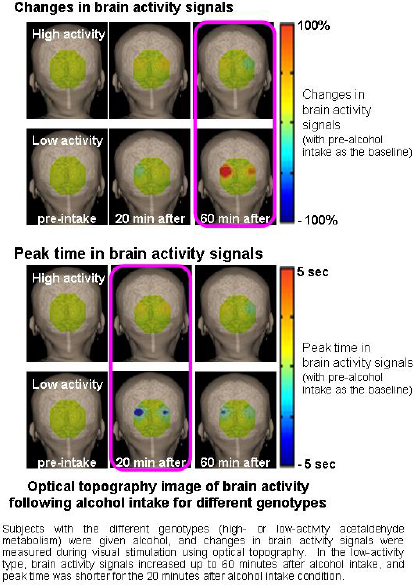
 |
 News releases News releases |
 |
 |
 |
  PDF Download(PDF Type, 221Kbyte) PDF Download(PDF Type, 221Kbyte) |
 |
 July 15, 2005 July 15, 2005 |
 |
| Successful imaging of brain activity after alcohol intake using Optical Topography Cerebral blood volume differences observed following visual stimulation depending on genotype-based alcohol sensitivity |
 |
|
 |
Tokyo, 15th July 2005 - The Osaka University Graduate School of Medicine (Professor Kanehisa MORIMOTO, henceforth"Osaka University")*1, in cooperation with the Advanced Research Laboratory of Hitachi, Ltd. (NYSE:HIT / TSE:6501, henceforth"Hitachi"), have shown for the first time that cerebral blood volume differences arise in the brain after alcohol intake, depending on the genotype related to alcohol metabolism*2 by using Optical Topography*3 (OT). The results of this study indicate that the effect of metabolites on brain function can be observed using OT, and is an important achievement in furthering studies on the effects of pharmaceutical drugs and metabolites on brain functions.
This research is reported in the paper entitled,"Effects of alcohol on hemodynamic and cardiovascular reaction in different genotypes," published in Psychiatry Research: Neuroimaging, an official publication of the International Society for Neuroimaging in Psychiatry, Volume 139, Issue 1, 30 May 2005, pp. 65-72.
At the forefront of brain science research, work is being conducted on clarifying the effects of pharmaceutical drugs and metabolites on brain functions. Within the body, the metabolism of various substances is spurred by the work of enzymes, and how these enzyme work, are determined by individual genotypes. As a result, to determine the effects of drugs and metabolites, it is necessary to consider the genotype of the subjects. Further, to determine changes in effect over time, it is important to measure changes in brain function over a period of hours.
The research teams at Osaka University and Hitachi, used OT to measure the changes in brain function after alcohol intake. It is known that there are three genotypes of aldehyde dehydrogenase 2 (ALDH2) which metabolize acetaldehyde (AcH), an intermediate metabolite of alcohol: a high-activity type, a low-activity type and a non-active type in East Asians. Two groups of subjects with the different genotypes (6 high-activity, 4 low-activity) were given pure alcohol at 0.4ml/kg of body weight. The brain activity in the visual cortex during a visual stimulation was measured 20 minutes before intake, directly after intake, and 20, 40, 60 minutes after intake by using OT. Each measurement lasted 10 minutes.
The results showed that with the low-activity type subjects, brain activity following a visual stimulus, differed significantly for the before and after alcohol intake conditions. The changes were statistically analyzed, and it was found that a significant increase occurred up to 60 minutes after intake and that at the"20 minutes after" measurement, the time taken to reach the maximum level of brain activity signal was significantly shorter.
These results are the first findings that show changes in brain activity signals are influenced by the genotype related to alcohol metabolism, and that the effect of metabolites on brain function can be measured using OT. This may be considered an important achievement in the development of pharmaceutical drugs for individual constitutions, and in furthering studies on the effects of pharmaceutical drugs and metabolites on brain functions.
 |
| Optical topography image of brain activity following alcohol intake for different genotypes |
| Notes |
| *1) |
Department of Social and Environmental Medicine, Graduate School of Medicine, Osaka University, 2-2-F1 Yamada-oka, Suita-shi, Osaka 567-0871, JAPAN. Tel: +81-(0) 6-6879-3920 |
| *2) |
Aldehyde dehydrogenase 2(ALDH2):Acetaldehyde (AcH), an intermediate metabolite of alcohol. East Asians show different AcH levels because of a genetic variation, an inactive form mitochondrial aldehyde dehyderogenase 2 (ALDH2): high-activity type, low-activity type, and non-active type. With the high-activity type, as acetaldehyde is metabolized (efficiently), the person with this genotype has strong alcohol resistance. In reverse, persons with the low-activity type are generally known to have low alcohol resistance. In East Asians (mongoloid race), the approximate distribution of these genotypes is just under 50% for high-activity, 40% for low-activity, and a few percent with the non-active type. |
| *3) |
Optical Topography (OT) equipment: The light used in OT has low photon energy and thus is safe for human use. The light also transmits through the body well. For this reason, when the light is irradiated on the scalp, it transmits through the scalp and the cranium, and reflections from the cerebral cortex are measurable. The light is absorbed by the hemoglobin in the blood, and thus by measuring the strength of the reflected light, it is possible to measure changes in cerebral blood volume which occurs as a result of changes in brain activity in a local area. Thus, by using OT, it is possible to simultaneously measure local hemodynamic responses at multiple points, and visualize brain activity. |
| *4) |
Brain function imaging technique: Various functions are localized in certain areas of the brain; a characteristic called functional localization. By observing activity in regional areas, it is possible to determine the relationship between various stimuli and brain activity. |
| About Hitachi, Ltd. |
| Hitachi, Ltd., (NYSE: HIT), headquartered in Tokyo, Japan, is a leading global electronics company with approximately 347,000 employees worldwide. Fiscal 2004 (ended March 31, 2005) consolidated sales totaled 9,027.0 billion yen ($84.4 billion). The company offers a wide range of systems, products and services in market sectors including information systems, electronic devices, power and industrial systems, consumer products, materials and financial services. For more information on Hitachi, please visit the company's website at http://www.hitachi.com. |
|
|
 |
| Information contained in this news release is current as of the date of the press announcement, but may be subject to change without prior notice. |
|
 |
 |
PDF files are in Adobe's Portable Document Format. To view them you need Adobe(R) Reader(R) by Adobe Systems Incorporated. |
|
 |
|
 |
|